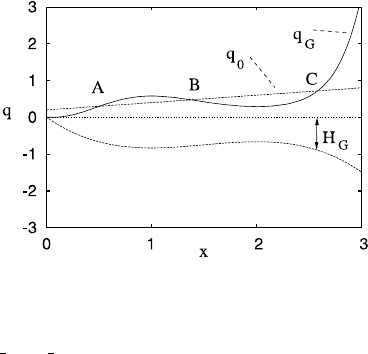Fowler A. Mathematical Geoscience
Подождите немного. Документ загружается.


650 10 Glaciers and Ice Sheets
10.2.7 The Grounding Line
In the transition region, we need to retain terms which are of importance in both ice
sheet and ice shelf approximations. This requires us to rescale the ice sheet scaled
variables in the following way:
x −x
G
∼γ, z,b ∼β, s ∼δβ, u ∼
1
β
,w∼
1
γ
,
t ∼β, p,τ
1
∼
δβ
ε
2
,τ
3
∼
δβ
2
γ
,τ∼
δβ
ε
,
(10.147)
where x
G
is the grounding line position; the parameters β and γ are defined by
β =
ε
δ
n
n+2
1
A
1
n+2
,γ=βε. (10.148)
This rescaling reintroduces the full Stokes equations. Denoting the rescaled vari-
ables (except time) by capitals, and writing
x −x
G
(t) =γX, t =βt
∗
, (10.149)
we derive the model
U
X
+W
Z
=0,
0 =−S
X
+T
3Z
−P
X
+T
1X
,
0 =−P
Z
−T
1Z
+T
3X
,
U
Z
+W
X
=T
n−1
T
3
,
2U
X
=T
n−1
T
1
,
T
2
=T
2
3
+T
2
1
.
(10.150)
The boundary conditions are the following. On the surface Z =δS,
T
3
+δ(P −T
1
)S
X
=0,
P +T
1
+δT
3
S
X
=0,
W =δ(γS
t
∗
−˙x
G
S
X
) +δUS
X
−γa,
(10.151)
where ˙x
G
=
dx
G
dt
∗
. On the base Z = B, when X>0,
−T
3
+(−P +T
1
)B
X
=(S +B)B
X
,
S +B =−[P +T
1
+T
3
B
X
],
W =γB
t
∗
−˙x
G
B
X
+UB
X
−γm,
(10.152)
and when X<0,
W =0,U=0, (10.153)
where we assume that the sliding velocity is zero for grounded ice.
12
12
This simple assumption is not very realistic, since it is most likely that in the vicinity of the
grounding line, the basal ice will be at the melting point, and the sliding velocity will be non-zero.
Where ice streams go afloat, the velocity is almost entirely due to basal sliding.

10.2 The Shallow Ice Approximation 651
To leading order, we can approximate the top surface boundary conditions as
γ →0 and also δ →0by
T
3
=P +T
1
=W =0onZ =0. (10.154)
The kinematic condition at the shelf base is approximately
W =−˙x
G
B
X
+UB
X
on Z =B. (10.155)
In addition, the solution must be matched to the outer (sheet and shelf) solutions.
We consider first the ice sheet behaviour as x → x
G
. We suppose that the ice sheet
is described in one dimension by (10.45), thus
H
t
=−q
x
+a, (10.156)
where the ice flux is (in ice sheet scaled variables)
q =
(s −b)
n+2
(−s
x
)
n
n +2
. (10.157)
We can carry out a local analysis near x
G
similar to those in Sect. 10.2.5.Asx →
x
G
, s −b → 0 (since s −b ∼ β 1), but the ice flux is non-zero; in this case we
find that always
H =s −b ∼C(x
G
−x)
n
2(n+1)
,q∼q
G
=
n
2(n +1)
n
C
2n+2
n +2
. (10.158)
When the surface slope is computed from this, we find that the requisite matching
condition for the slope written in terms of the transition zone scalings is that
S
X
∼−
nC
2(n +1)
1
(−δX)
n+2
2(n+1)
as X →−∞. (10.159)
Clearly the presence of the small parameter δ does not allow direct matching of the
transition zone to the ice sheet.
The problem is easily resolved, however. There is a ‘joining’ region in which
X =
˜
X/δ, S =
˜
S/δ, and then also P,T
1
,W ∼ δ; the resultant set of equations is
easily solved (it is a shear layer like the ice sheet), and we find
˜
S =B
G
+
(−B
G
)
2(n+1)/n
−
2(n +1)
n
(n +2)q
G
1/n
˜
X
n/(2n+2)
, (10.160)
where B = B
G
at x = x
G
. Expanding this as
˜
X → 0, we find that the matching
condition for S in the transition zone as X →−∞is
S ∼−ΛX, (10.161)
where
Λ =
{(n +2)q
G
}
1/n
(−B
G
)
(n+2)/n
. (10.162)
A final simplification to the transition zone problem results from defining
Π =P +S; (10.163)

652 10 Glaciers and Ice Sheets
to leading order in γ and δ, the transition problem is then
U
X
+W
Z
=0,
Π
X
=T
3Z
+T
1X
,
Π
Z
=−T
1Z
+T
3X
,
U
Z
+W
X
=T
n−1
T
3
,
2U
X
=T
n−1
T
1
,
T
2
=T
2
3
+T
2
1
,
(10.164)
together with the boundary conditions
T
3
=W =0onZ =0, (10.165)
B =−(Π +T
1
+T
3
B
X
),
T
3
(1 −B
2
X
) =2T
1
B
X
,
W =(−˙x
G
+U)B
X
on Z =B, X > 0,
(10.166)
and
W =U =0onZ =B
G
,X<0. (10.167)
The matching conditions to the ice sheet may be summarised as
Π
X
→−Λ, W →0,T
3
→−ΛZ as X →−∞, (10.168)
with the flow becoming the resultant pressure gradient driven shear flow at −∞.
Towards the ice shelf, a comparison of orders of magnitude shows firstly that
ν
β
=
γ
λ
1/(n+1)
1, (10.169)
and that in the ice shelf, the transition scaled variables are
S,B ∼
ν
β
,W∼
γ
λ
,P,T
1
∼
ν
β
,T
3
∼
ν
β
2
γ
λ
; (10.170)
note also that the ice shelf time scale νλ is much less than the transition zone time
scale β, so that it is appropriate in the transition zone to assume that the far field ice
shelf is at equilibrium, and thus described by (10.145) and (10.146).Bearinginmind
(10.169), it follows from this that suitable matching conditions for the transition
region are
T
1
∼−
1
4
B, U ∼MX
1/(n+1)
,
W →0,B∼−
q
I
U
as X →∞,
(10.171)
where
M =
(n +1)
2
q
I
4
n
1/(n+1)
, (10.172)
10.2 The Shallow Ice Approximation 653
and the flow becomes an extensional flow as X →∞. It follows from integration
of the continuity equation between B and S that the ice flux to the ice shelf, q
I
,is
given by
q
I
=q
G
+˙x
G
B
G
. (10.173)
The top surface is defined by
S =(Π +T
1
)|
Z=0
, (10.174)
and uncouples from the rest of the problem. The extra condition on Z =B, X > 0
in (10.166) should determine B providing ˙x
G
is known. This is the basic conundrum
of the grounding line determination, since there appears to be no extra condition to
determine ˙x
G
.
The resolution of this difficulty has not yet been finally achieved. One might won-
der whether there is an extra condition hiding in the matching conditions (10.168)
or (10.171), but it appears not: the conditions on T
3
and W as X →−∞imply
the pressure gradient condition, while the condition on U as X →∞implies the
other three. It seems that the answer lies in the additional posing of contact condi-
tions. Specifically, for the solution in the transition region to have physical sense,
we require that the effective normal stress downwards, −σ
33
−p
w
, be positive on
the grounded base, and we require the ice/water interface to be above the submarine
land surface on the floating shelf base. When written in the current scaled coordi-
nates, these conditions become
B +Π +T
1
> 0,X<0,
B>B
G
,X>0.
(10.175)
In addition, we may add to these the condition that at the grounding line, the effec-
tive normal stress is zero, whence
B +Π +T
1
=0atX =0. (10.176)
Numerical solutions appear to be consistent with the idea that, for any given ˙x
G
,
there is a unique value of Λ such that the contact conditions (10.175) and (10.176)
are satisfied. If this is true, then (10.162) determines the ice sheet flux q
G
at the
grounding line as a function of x
G
(through B
G
) and ˙x
G
, and this provides the extra
condition (as well as s →b as x → x
G
−) for the determination of the grounding
line position.
10.2.8 Marine Ice Sheet Instability
Much of the interest concerning grounding line motion concerns the possible insta-
bility of marine ice sheets. A marine ice sheet is one whose base is below sea level;
the major example in the present day is the West Antarctic Ice Sheet. Marine ice
sheets terminate at grounding lines, from which ice shelves protrude. Depending
on the slope of the submarine surface, they can be susceptible to instability, and it

654 10 Glaciers and Ice Sheets
Fig. 10.8 Var ia ti on o f q
G
[H
G
(x)] and the equilibrium flux q
0
=ax for the bottom depth profile
H
G
indicated. Equilibria occur for the points of intersection of the two flux curves, with instability
occurring if q
0
>q
G
. Thus points A and C are stable, while B is unstable. The particular functions
used are H
G
=2x −
3
2
x
2
−
1
3
x
3
, q
G
=H
3
,andq
0
=0.2(1 +x) (with the divide implicitly being
at x =−1)
has been postulated that fluctuations in sea level, for example, might cause a catas-
trophic retreat of the grounding lines in West Antarctica, and consequent collapse
of the ice sheet.
To understand why this might be so, consider an ice sheet governed by the mass
conservation equation (10.156), and for simplicity (it does not affect the argument),
take the ice flux q =−H
x
, so that
H
t
=H
xx
+a, (10.177)
with boundary conditions
H
x
=0atx =0,
H =H
G
(x
G
), −H
x
=q
G
(H ) at x =x
G
(10.178)
(note that we retain here the finite depth of the ice sheet at the grounding line).
H
G
(x) represents the depth of the land subsurface below sea level, and we assume
that q
G
is an increasing function of H , as suggested by (10.162), if Λ is constant.
There is a steady solution H = H
0
(x); note that since the ice sheet slopes down to
the ice shelf, we have H
0
(x
G
)<H
G
(x
G
).
Consider a situation such as that shown in Fig. 10.8, in which the subsurface
slopes upwards for part of the domain. In this case there can be three possible
equilibria, of which the middle one is unstable. The casual argument for this is
the following suggestion: if x
G
advances, then the ice sheet must deliver a larger
flux q
0
; however, assuming q
G
(H ) > 0, then in regions where H
G
(x) < 0 (i.e., the
bed slopes upwards towards the grounding line), the actual flux delivered is less;
consequently, the ice builds up behind the grounding line, causing its further ad-
vance.
To demonstrate this mathematically, we linearise (10.177) and (10.178) about the
steady state H =H
0
(x), x
G
= x
0
G
, by putting H = H
0
(x) + η, x
G
= x
0
G
+γ ;the

10.3 Sliding and Drainage 655
resulting linearised system for η is (eliminating γ )
η
t
=η
xx
,
η
x
=0atx =0,
−η
x
=Kη at x =x
0
G
,
(10.179)
where
K =
q
G
(H
G
)H
G
(x
0
G
) −a
H
G
(x
0
G
) −H
0
(x
0
G
)
, (10.180)
which has (stable) solutions η = e
−λ
2
t
cosλx providing λ tan λx
0
G
= K.IfK>0,
these are the only solutions, and the steady state is stable. However, if K<0, the
first mode (with λx
0
G
<
1
2
π) is replaced by an unstable mode η = e
λ
2
t
coshλx,
where λ tanhλx
0
G
=−K. Therefore the steady state is unstable precisely if K<0.
Consulting (10.180), and recalling that H
0
(x
G
)<H
G
(x
G
), it follows that the steady
state is unstable if
dq
G
dx
G
<a, (10.181)
as suggested in Fig. 10.8. Question 10.8 generalises this result to the case where
q =−D(H,H
x
)H
x
.
10.3 Sliding and Drainage
The sliding law relates the basal shear stress τ
b
to the basal sliding velocity u
b
.The
classical theory, enunciated by Lliboutry, Weertman, Nye, Kamb, and others, con-
siders ice flowing at the base of a glacier over an irregular, bumpy bedrock. The
ice is lubricated at the actual interface by the mechanism of regelation, or melting-
refreezing, which allows a thin film (microns thick) to exist at the ice-rock interface,
and allows the ice to slip. The drag is then due to two processes; regelation itself,
and the viscous flow of the ice over the bedrock. Regelation is dominant for small
wavelength roughness, while viscous drag is dominant for large wavelengths, and
early work emphasised the importance of a controlling (intermediate) wavelength
(of several centimetres). More recently, the emphasis has moved away from rege-
lation and has been put more on consideration of the viscous flow, and we do this
here, assuming no normal velocity of the ice as it slides over the bed.
A suitable model for discussion is the flow of a Newtonian fluid over a rough
bedrock of ‘wavelength’ [x] and amplitude [y], given by
y =h
D
(x) ≡[y]h
x
[x]
, (10.182)

656 10 Glaciers and Ice Sheets
where y is now the vertical coordinate.
13
The governing equations for two-
dimensional flow down a slope of angle α are
u
x
+v
y
=0,
p
x
=ρ
i
g sin α +η∇
2
u,
p
y
=−ρ
i
g cos α +η∇
2
v,
(10.183)
where η is the viscosity. We suppose that the glacier has a depth of order d, thus
providing a basal shear stress τ
b
of order [τ ], which drives a shear velocity of order
[u], and these are related by
[τ ]=ρ
i
gd sin α =
η[u]
d
. (10.184)
The basal boundary conditions are those of no shear stress and no normal flow, and
take the form
σ
nt
=
τ
2
(1 −h
2
D
) −2τ
1
h
D
1 +h
2
D
=0, (10.185)
where
τ
1
=2ηu
x
,τ
2
=η(u
y
+v
x
), (10.186)
and
v =uh
D
, (10.187)
both (10.185) and (10.187) being applied at y =h
D
(x). Note also that the normal
stress is
−σ
nn
=
p(1 +h
2
D
) +τ
1
(1 −h
2
D
) +2h
D
τ
2
1 +h
2
D
. (10.188)
Because we describe a local flow near the base of the glacier, it is appropriate to
apply matching conditions to the ice flow above. In particular, we require τ
2
→τ
b
as y becomes large, and hence
u ∼u
b
+
τ
b
y
η
(10.189)
far from the bed.
We non-dimensionalise the equations by scaling
x,y ∼[x],u,v∼[u],τ
b
=[τ ]τ
∗
,u
b
=[u]u
∗
,
p =p
i
+
ν[τ ]
σ
P,
(10.190)
where
p
i
=p
a
+ρ
i
g(y
i
−y)cos α (10.191)
13
Because shortly we will use z for the complex variable x +iy.

10.3 Sliding and Drainage 657
is the ice overburden pressure, and y =y
i
∼d is the ice upper surface (and taken as
locally constant); this leads to the non-dimensional set
u
x
+v
y
=0,
νP
x
=σ
2
+∇
2
u,
νP
y
=∇
2
v,
(10.192)
subject to the boundary conditions that
P →0,u∼u
∗
+στ
∗
y as y →∞, (10.193)
and
1 −ν
2
h
2
(u
y
+v
x
) −4νh
u
x
=0,
v =νuh
,
(10.194)
on the dimensionless bed y =νh (from (10.182)). The corrugation σ and the aspect
ratio ν are defined by
σ =
[x]
d
,ν=
[y]
[x]
; (10.195)
ν is a measure of the roughness of the bed.
We will assume that both ν and σ are small. In consequence, the dimensionless
basal stress τ
∗
in (10.193) is uncoupled from the problem; however, integration of
the momentum equations over the domain yields an expression for τ
∗
. In dimen-
sional terms, this relation is
τ
b
=
1
L
L
0
σ
n1
ds, (10.196)
where the integral is over a length L of the base y = h
D
, over which conditions are
taken to be periodic (alternatively, the limit L →∞may be taken).
Evidently, the velocity is uniform to leading order, and therefore we write
u =u
∗
+νU, v =νV, (10.197)
so that the problem reduces to
U
x
+V
y
=0,
P
x
=
σ
2
ν
+∇
2
U, (10.198)
P
y
=∇
2
V,
with boundary conditions
U ∼
στ
∗
ν
y as y →∞, (10.199)
and
1 −ν
2
h
2
(U
y
+V
x
) −4νh
U
x
=0,
V =(u
∗
+νU)h
(10.200)

658 10 Glaciers and Ice Sheets
on y =νh. When written in dimensionless terms, the overall force balance (10.196)
takes the form (with L now being dimensionless)
στ
∗
ν
2
=
1
L
L
0
P
1 +ν
2
h
2
+2
1 −ν
2
h
2
U
x
+2νh
(U
y
+V
x
)
h
dx
1 +ν
2
h
2
.
(10.201)
It is fairly clear from (10.201) that there is a distinguished limit σ ∼ν
2
, which corre-
sponds to the situation where sliding is comparable to shearing, and it is convenient
to adopt this limit as an example. We introduce a stream function ψ via
U =ψ
y
,V=−ψ
x
; (10.202)
then letting ν →0 with σ ∼ν
2
, we derive the reduced model
P
x
=∇
2
ψ
y
,
P
y
=−∇
2
ψ
x
,
(10.203)
together with the boundary conditions
P,ψ →0asy →∞,
ψ =−u
∗
h(x), ψ
yy
−ψ
xx
=0ony =0.
(10.204)
The shear stress is determined by (10.201), whence to leading order (e.g., if h is
periodic with period 2π)
στ
∗
ν
2
=
1
2π
2π
0
(P +2ψ
xy
)|
y=0
h
dx; (10.205)
more generally a spatial average would be used. Since the expression in brackets in
(10.205) is simply (minus) the normal stress, it is therefore also equal to the scaled
water pressure in the lubricating film, which from (10.190) can be written in the
form
P +2ψ
xy
=−N
∗
,N
∗
=
σ(p
i
−p
w
)
ν[τ ]
. (10.206)
The quantity N
∗
is the dimensionless effective pressure at the bed. We come back
to this below.
A nice way to solve this problem is via complex variable theory. We define the
complex variable z =x +iy, and note that Eqs. (10.203) are the Cauchy–Riemann
equations for the analytic function P +i∇
2
ψ. Consequently, ψ satisfies the bihar-
monic equation, which has the general solution
ψ =(¯z −z)f (z) −B(z) +(cc), (10.207)
where f and B are analytic functions and (cc) denotes the complex conjugate, as
does the overbar. The zero stress condition (10.204) requires f =−
1
2
B
, and also
B →0asz →∞(with Im z>0), and the last condition is then
B +
¯
B =u
∗
h on Im z =0. (10.208)

10.3 Sliding and Drainage 659
If h is periodic, with a Fourier series
h =
∞
−∞
a
k
e
ikx
, (10.209)
then B is simply given by
B =u
∗
∞
1
a
k
e
ikz
(10.210)
(we can assume a
0
=0, i.e., the mean of h is zero). However, it is also convenient
to formulate this problem as a Hilbert problem. We define L(z) =B
(z), which is
analytic in Im z>0, and then L(z) =
B
(¯z) is analytic in Im z<0. From (10.207),
∇
2
ψ = 4ψ
z¯z
=−2(L +
¯
L), and therefore P +i∇
2
ψ + 4iL = P + 2i(L −
¯
L) is
analytic; since this last expression is real, it is constant and thus zero, since it tends
to zero as z →∞. Applying the boundary conditions at Im z = 0, and using the
usual notation for the values on either side of the real axis, it follows that
L
+
+L
−
=u
∗
h
,
L
+
−L
−
=
1
2
iP,
(10.211)
which relate the values either side of Im z = 0. From (10.207), we have ψ
xy
=
i(ψ
zz
− ψ
¯z¯z
) =
1
2
i(z −¯z)(B
− B
), and thus ψ
xy
|
y=0
= 0; it follows that P =
−N
∗
on y = 0, and the drag (i.e., the sliding law) is then computed (for a 2π-
periodic h)as
στ
∗
ν
2
=
1
iπ
2π
0
(L
+
−L
−
)h
dx; (10.212)
evaluating the integral, we find
στ
∗
ν
2
=4u
∗
∞
1
k
3
|a
k
|
2
. (10.213)
For a linear model such as this, τ
∗
and thus τ
b
is necessarily proportional to u
∗
and
thus u
b
. For Glen’s flow law, the slip coefficient multiplying τ
∗
becomes
σ
ν
n+1
.The
problem cannot be solved exactly, but variational principles can be used to estimate
a sliding law of the form
τ
b
≈Ru
1/n
b
. (10.214)
Weertman’s original sliding law drew a balance between (10.214) and the linear
dependence due to regelation, and the heuristic ‘Weertman’s law’ τ
b
∝ u
1/m
b
, with
m ≈
1
2
(n +1) is often used.
Simplistic sliding laws such as the above have been superseded by the inclusion
of cavitation. When the film pressure behind a bump decreases to a value lower
than the water pressure in the local subglacial drainage system, a cavity must form,
